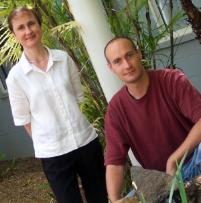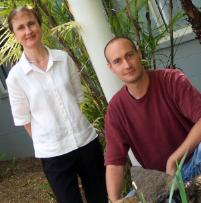Paradise found - new CQU lecturers find niche in Bundy
Published on 24 August, 2005
Imagine how good you would feel if you had recently moved to a peaceful, sub-tropical paradise.
Such is the experience of CQU Bundaberg Campus’ two newest full-time lecturers, Dr Merryn Ekberg and Dr Ken Bordignon.
Although they hail from disparate backgrounds (what could be more different than a medical sociologist from ‘the thick’ of Melbourne city and an aerospace engineer from the Californian desert) both are happy to have found an ideal place to spend the next phase of their lives – right here in our midst!.
Dr Ekberg exudes enthusiasm. Having worked in universities for the past 16 years, she is now in the envious position of being able to do what she wants to professionally.
She has recently taken charge of the Health & Medical Sociology course at CQU.
“This is my area. I am totally re-writing the course and working flat out to get it finished for approval for next year," she said.
Recently offered a post at both Central Queensland University and Kings College London, Dr Ekberg had a difficult decision to make.
“In the end I chose the permanent position at CQU – it was the right decision. I love it here. I enjoy the people – enthusiastic students and the staff are particularly friendly.”.
 In addition to teaching, re-writing courses and completing a book for Cambridge University Press, Dr Ekberg is also currently writing two grant applications. One is an internal solo application and the other is for a National Health and Medical Research Council grant which will enable her to start up two new research projects at CQU.
In addition to teaching, re-writing courses and completing a book for Cambridge University Press, Dr Ekberg is also currently writing two grant applications. One is an internal solo application and the other is for a National Health and Medical Research Council grant which will enable her to start up two new research projects at CQU.
“Nicola Taylor, the Sociology of Science & Technology lecturer in Rockhampton is also involved with this. If the application is successful we will try to attract some PhD students. I love my research," she said.
Dr Ekberg completed a Bachelor of Science (Biomedical Science), which was her initial field of interest, and then worked at the Walter and Eliza Hall Institute of Medical Research in Melbourne. Here she was involved in cancer research with some of Australia’s top medical scientists “which was an absolute privilege”.
Dr Ekberg’s research at the Hall Institute focussed on the genetics of cancer.
“I learned so much from those people,” she enthused. “While working at the Institute I completed an Arts degree in Politics and Sociology – my area was the politics and sociology of science and technology. Doing both at the same time, I could really see these two areas meshing together, a hybridisation between the two.”.
Realising it was a niche where not much work was being done, Dr Ekberg began to see the importance of the whole area of medical sociology and so decided to continue her study and complete a PhD in that area.
“I got a lot of encouragement from everyone because I was the only person in Australia doing this," she said.
Being completely passionate about medical sociology, Dr Ekberg set straight to work on her project, unlike other PhD students who often spend the first 12 months designing the project.
“I am very passionate about my work. My ultimate ambition is to reach professorial level.”.
Last week, Dr Ekberg had another paper accepted by a top international journal – Health Risk & Society.
“The Editor is based in England at Kent University. Initially I was too nervous to even open the email! Then I was thrilled to discover it had been accepted with only minor revisions required.” This paper explored maximising the benefits and minimising the risks associated with pre-natal genetics testing.
Dr Ekberg has had five papers published since completing her PhD in 2004 and has many more in the pipeline. She has also been invited to co-edit a new International Journal of Science and Research.
After completing her PhD at the University of Melbourne, Dr Ekberg was offered a three-year Post Doctoral Fellowship at RMIT University in Melbourne. She was based in the Centre for Risk and Community Safety because a lot of her work focussed on the sociology of risk and the sociology of health risk. It is fresh from this background that CQU has had the great fortune to welcome Dr Ekberg.
And what vision does Dr Ekberg have for the sociology degree programs at CQU?.
“I’d really like to see sociology grow in strength and numbers, encouraging more research students into honours and post graduate studies. I want to build up the areas of health and medical sociology and also encourage nurses to become more involved in the area. Perhaps there is also scope for collaborative work between sociology and biomedical science," she said.
“Sociology is one of the best subjects to do in first year because it’s nice and broad - a good introduction to other courses like psychology and social work, all the Arts and Humanities, even journalism. It provides a good grounding for life in general and teaches us about people, society and the world we live in. Therefore it is a practical subject, very employable.
“Students tend to enjoy the subject – it really opens their eyes," she said.
The former professional classical dancer says she has moved to Bundaberg indefinitely.
“I am actually a bit of a country person. I come from the thick of the city and the contrast here is just paradise. I love it! Bundaberg has all the facilities with an out-of-the-city feeling that agrees with me.”.
Dr Ken Bordignon, CQU’s new Aviation Technology lecturer, echoes this general sentiment.
“Bundaberg is nice. It has a great equitable climate, a small town kinda feel – open and friendly. I don’t want to live in a big urban environment," he said.
Dr Bordignon completed a Bachelor of Science in Aerospace Engineering at the University of Notre Dame in South Bend, Indiana, USA and a Masters in Science and PhD in Aerospace Engineering from Virginia Polytechnic Institute & State University, Blacksburg, Virginia, USA.
“I was good at math in high school so decided to do Engineering at college because it was a good combination of math and science. Things that move fast were more interesting than things that move slowly so Aerospace Engineering had more appeal to me.”.
 It was while studying his Bachelor degree that Dr Bordignon realised he enjoyed teaching other people how to do things more than actually doing it himself.
It was while studying his Bachelor degree that Dr Bordignon realised he enjoyed teaching other people how to do things more than actually doing it himself.
“This is what ultimately motivated me to teach here now. Overall I am happy with my decision to study Aerospace Engineering. It was a good decision. I have enjoyed a lot of the things that have resulted from it.
“My students are highly motivated and very curious about the work they are doing. They ask lots of good questions. All the students are there because they want to be and as such are very interested in the material.”.
After completing his degrees, Dr Bordignon worked in industry. One program he was involved in was with Lockeed Martin Aeronautics Company where he was part of a team that designed an aircraft known as the X-35B. The X-35 family of aircraft were three variants of the concept demonstration aircraft for the Joint Strike Fighter competition which was recorded in the NOVA documentary The Battle of the X-Planes.
At Lockheed Martin, Dr Bordignon worked on the STOVL (Short Take-Off/Vertical Landing) Flight Control System for the X-35B. This unique propulsion system which enabled the aircraft to hover and land vertically (and become the first and only aircraft in history to perform a short take-off, a level supersonic dash, and a vertical landing in a single flight) won the prestigious Collier Trophy. The award recognises the greatest achievement in aeronautics or astronautics in America, specifically for improving the performance, efficiency, and safety of air or space vehicles, the value of which has been thoroughly demonstrated by actual use during the preceding year.
This experimental aircraft is now on display at the Smithsonian Institute’s National Air & Space Museum at the Steven F Udvar-Hazy Centre.
Interested in studying Aviation Technology at CQU? Dr Bordignon recommends that prospective students have a basic understanding of maths and physics.
“The degree is not geared toward someone who wants to be an airplane mechanic or designer of aircraft so you don’t need intricate mathematical knowledge. You will possibly end up being a pilot or somehow involved in the aviation industry. So it’s good to know basically how things work – what hazards there are, things that are good or bad for the machine. A good analogy would be that you can drive a car without knowing how to build the car – but it’s good to know how to check the oil and know what the dials and gauges are used for,” he said. “One past graduate is now working with Boeing while another opened up his own airfield.”.
Dr Bordignon hopes to help develop the course over the next three years.
“It’s a relatively new program – only four years old. I may re-write some components but would really like to develop some continuity and grow the program. Historically, we normally have about 20 students enrolled in the Aviation Technology program for each year level. If I can generate greater interest then that will be fantastic.”

